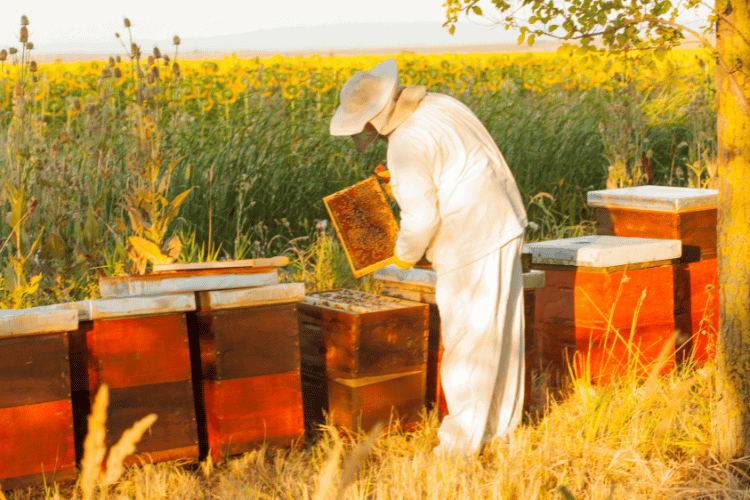As the late summer fades into the fall months, many beekeepers notice increased defensive behaviors and stinging incidents around their hives.
Both honey bees and yellow jackets exhibit higher aggression during this time of year. This rise in aggressive reactions is not meant as an act of malice by these important pollinators.
Rather, it stems from the stresses facing bees and wasps in the fall as temperatures cool, food sources dwindle, and colonies prepare for the demands of winter.
TL;DR
Bees become more aggressive in the fall due to declining food sources, increased foraging to prepare for winter, reproductive swarming leading to overcrowding, and varroa mite infestations. Defensive behavior peaks as colonies work to amass enough honey stores and protect the hive.
Main Reasons Behind Bee Aggression in the Fall

Here are the main reasons bees become aggressive in the fall:
Declining Food Sources
One of the main reasons behind increased fall bee aggression is a decline in available food sources. As many flowers, plants, and trees bloom less in the late summer and fall, bees have fewer places to gather nectar and pollen.
This dearth of nutrition stresses the hive at a time when colonies are working to raise winter bees and store away food for the cold weather ahead.
Bees can become more territorial and defensive of whatever meager food sources remain available. They will vigorously protect any sugar-rich foods they can find, especially in regions where autumn brings less rain and drier conditions.
A lack of nutrition prevents bees from producing as much of their anti-microbial propolis and honey stores too, leaving hives more vulnerable to pests and diseases.
Preparing for Winter
Honey bees amplify their foraging efforts in the fall months to collect and store away as much pollen and nectar as possible.
This build-up of food reserves in the hive is essential for the colony to survive the winter months when they remain mostly in the hive and cannot forage outside.
As bees work harder to prepare for winter, their activity around the hive increases significantly. This inevitably leads to more encounters and conflicts with humans that accidentally get too close.
Defensive behaviors peak as worker bees guard the precious honey stores and ensure the queen and young survive the cold weather ahead.
Yellow jackets similarly prepare for winter but build expansive nests rather than store food. Their nests can grow extremely large by late summer, resulting in fierce defense of the area.
It’s key to avoid yellow jacket nests and destroy any nests around your home before winter so populations don’t surge the following year.
Also Read: Where Do Bees Go in the Winter?
Reproductive Swarming
Some bee colonies may also produce reproductive swarm cells in the fall months. This can lead to overcrowding and increased competition for the limited food resources available.
A lack of space and nutrition makes bees more territorial and likely to sting. New queens may take some weaker swarms and try to establish new colonies in the fall. This reproduction divides the worker population and leads to an imbalance of resources.
New swarms trying to survive going into winter are particularly defensive. Requeening colonies in late summer can help prevent this reproductive swarm impulse.
Impact of Varroa Mites

Varroa mite infestations and associated diseases are also peaking in the fall months as mite populations have had time to grow throughout spring and summer.
These parasitic mites weaken bees and make colonies far more susceptible to viral diseases. Weakened, sick bee colonies will become more aggressive as they decline.
The mites also trigger bees to forage more to try to sustain the struggling colony, again increasing defensive behaviors.
Using proper integrated pest management techniques to monitor and control mites is crucial to maintaining healthy hives with natural bee behavior.
Tips for Beekeepers to Reduce Bee Aggression
- Harvest excess honey supplies responsibly in late summer so bees have enough food stores for winter. Avoid taking too much.
- Requeen colonies with new, mated queens in early fall to prevent reproductive swarming and overcrowding issues.
- Monitor regularly for varroa mite levels and use integrated pest management techniques to control mites, such as drone comb traps, powders, and essential oils.
- Avoid opening up hives and disturbing bees as much as possible in the fall so they can focus on winter preparations.
- Use protective clothing and smoke when inspecting more aggressive hives to prevent stings.
- Set up wind barriers around hives and make sure entrances are reduced for winter so bees do not have to work as hard to defend against robbing.
- Provide a fresh water source near hives if no natural source is available.
- Work hives gently and quickly in the fall to reduce stress on bees.
- Consider requeening, especially in aggressive colonies with a different queen line known for gentleness.
- Wait for cooler evenings in fall when fewer guard bees are flying to do hive inspections or treatments.
Wrapping Up
The uptick in bee and wasp aggression during the fall is perfectly natural as they work to prepare for winter and respond to environmental stressors.
While their stinging defenses can be inconvenient for beekeepers, these are protective behaviors necessary for colony survival.
Being aware of the reasons behind this increase in aggression allows us to take proper precautions and care for bees effectively year-round.
Their pollination services and production of honey, beeswax, and propolis remain vital to both ecosystems and humans.
With proper practices, we can help our busy bee colonies calmly make it through the winter to pollinate another spring.
- Does Bleach Kill Bees? - April 23, 2024
- How Do I Get Rid of Ants Without Harming Bees? - April 16, 2024
- Do Bug Zappers Kill Bees? Completely Explained - April 9, 2024
